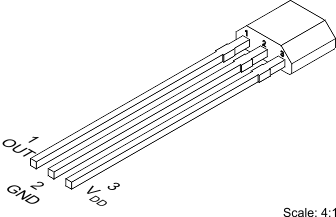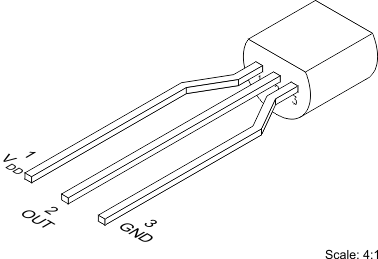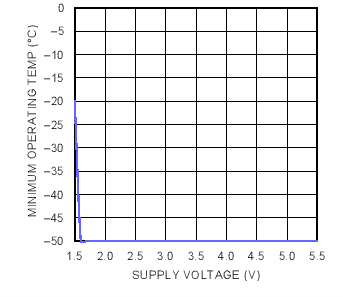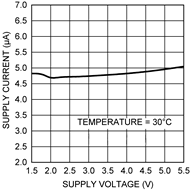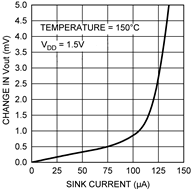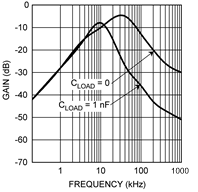-
LMT84 1.5、SC70/TO-92/TO-92S 模拟温度传感器
DATA SHEET
LMT84 1.5、SC70/TO-92/TO-92S 模拟温度传感器
本资源的原文使用英文撰写。 为方便起见,TI 提供了译文;由于翻译过程中可能使用了自动化工具,TI 不保证译文的准确性。 为确认准确性,请务必访问 ti.com 参考最新的英文版本(控制文档)。
1 特性
- LMT84LPG(TO-92S 封装)具有快速热时间常量,典型值为 10s(气流速度为 1.2m/s)
- 非常精确:典型值 ±0.4°C
- 1.5V 低压运行
- -5.5mV/°C 的平均传感器增益
- 5.4µA 低静态电流
- 宽温度范围:–50°C 至 150°C
- 输出受到短路保护
- 具有 ±50µA 驱动能力的推挽输出
- 封装尺寸兼容符合行业标准的 LM20/19 和 LM35 温度传感器
- 具有成本优势的热敏电阻替代产品
3 说明
LMT84 是一款精密 CMOS 温度传感器,其典型精度为 ±0.4°C(最大值为 ±2.7°C),且线性模拟输出电压与温度成反比关系。1.5V 工作电源电压、5.4μA 静态电流和 0.7ms 开通时间可实现有效的功率循环架构,以最大限度地降低无人机和传感器节点等电池供电 应用 的功耗。LMT84 LPG 穿孔 TO-92S 封装快速热时间常量支持非板载时间温度敏感型 应用, 例如烟雾和热量探测器。 得益于宽工作范围内的精度和其他 特性, 使得 LMT84 成为热敏电阻的优质替代产品。
对于具有不同平均传感器增益和类似精度的器件,请参阅 类似替代器件 了解 LMT8x 系列中的替代器件。
器件信息(1)
| 器件型号 | 封装 | 封装尺寸(标称值) |
|---|---|---|
| LMT84 | SOT (5) | 2.00mm x 1.25mm |
| TO-92 (3) | 4.30mm x 3.50mm | |
| TO-92S (3) | 4.00mm x 3.15mm |
(1) 如需了解所有可用封装,请参阅数据表末尾的可订购产品附录。
热时间常量
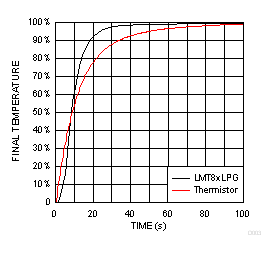
* 快速热响应 NTC
输出电压与温度间的关系
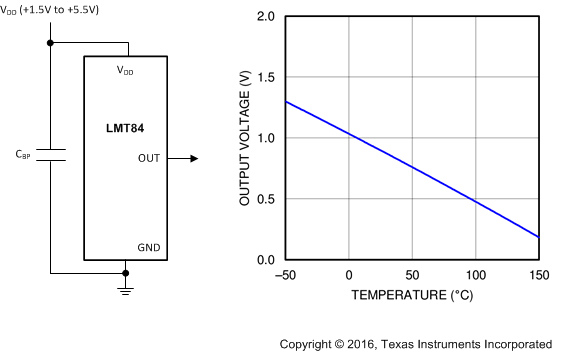
4 修订历史记录
Changes from D Revision (June 2017) to E Revision
- 将汽车器件移到了单独的数据表中 (SNIS178)Go
- Changed TO-92 GND pin number from: 1 to: 3 Go
- Changed TO-92 VDD pin number from: 3 to: 1 Go
Changes from C Revision (October 2015) to D Revision
- 将数据表更新为最新的文档和翻译标准Go
- 将 AEC-Q100 汽车标准项目符号添加到了“特性”中Go
- 添加了时间常量图Go
- 将磁盘驱动器、游戏、无线收发器和手机从“应用”中进行了删除Go
- Added LPG (TO-92S) packageGo
- Added Figure 10 to Typical CharacteristicsGo
Changes from B Revision (May 2014) to C Revision
- Deleted 所有涉及 TO-126 封装的内容Go
- Added TO-92 LPM pin configuration graphicGo
- Changed Handling Ratings to ESD Ratings and moved Storage Temperature to Absolute Maximum Ratings tableGo
- Changed KV to V Go
- Added layout recommendation for TO-92 LP and LPM packagesGo
Changes from A Revision (June 2013) to B Revision
- Changed 更改了数据表流程和布局,以符合 TI 新标准。在整个文档内添加了以下章节:应用范围和实施、电源建议、布局布线、器件和文档支持、机械、封装和可订购信息。Go
- Added 在文档中增加了 TO-92 和 TO-126 封装信息。Go
- Changed from 450°C/W to 275 °C/W. New specification is derived using TI ' s latest methodology. Go
- Deleted Note: The input current is leakage only and is highest at high temperature. It is typically only 0.001 µA. The 1 µA limit is solely based on a testing limitation and does not reflect the actual performance of the part. Go
5 Device Comparison Tables
Table 1. Available Device Packages
| ORDER NUMBER(1) | PACKAGE | PIN | BODY SIZE (NOM) | MOUNTING TYPE |
|---|---|---|---|---|
| LMT84DCK | SOT (AKA(2): SC70, DCK) | 5 | 2.00 mm × 1.25 mm | Surface Mount |
| LMT84LP | TO-92 (AKA(2): LP) | 3 | 4.30 mm × 3.50 mm | Through-hole; straight leads |
| LMT84LPG | TO-92S (AKA(2): LPG) | 3 | 4.00 mm × 3.15 mm | Through-hole; straight leads |
| LMT84LPM | TO-92 (AKA(2): LPM) | 3 | 4.30 mm × 3.50 mm | Through-hole; formed leads |
| LMT84DCK-Q1 | SOT (AKA(2): SC70, DCK) | 5 | 2.00 mm × 1.25 mm | Surface Mount |
(1) For all available packages and complete order numbers, see the Package Option addendum at the end of the data sheet.
(2) AKA = Also Known As
6 Pin Configuration and Functions
DCK Package
5-Pin SOT (SC70)
(Top View)

LP Package
3-Pin TO-92
(Top View)
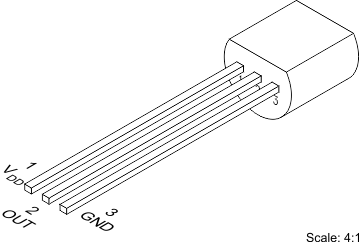
Pin Functions
| PIN | TYPE | DESCRIPTION | ||||
|---|---|---|---|---|---|---|
| NAME | SOT (SC70) | TO-92 | TO-92S | EQUIVALENT CIRCUIT | FUNCTION | |
| GND | 1, 2(1) , 5 | 3 | 2 | Ground | N/A | Power Supply Ground |
| OUT | 3 | 2 | 1 | Analog Output |
 |
Outputs a voltage that is inversely proportional to temperature |
| VDD | 4 | 1 | 3 | Power | N/A | Positive Supply Voltage |
(1) Direct connection to the back side of the die
7 Specifications
7.1 Absolute Maximum Ratings
See (1)(3)| MIN | MAX | UNIT | ||
|---|---|---|---|---|
| Supply voltage | –0.3 | 6 | V | |
| Voltage at output pin | –0.3 | (VDD + 0.5) | V | |
| Output current | –7 | 7 | mA | |
| Input current at any pin(2) | –5 | 5 | mA | |
| Maximum junction temperature (TJMAX) | 150 | °C | ||
| Storage temperature Tstg | –65 | 150 | °C | |
(1) Stresses beyond those listed under Absolute Maximum Ratings may cause permanent damage to the device. These are stress ratings only, which do not imply functional operation of the device at these or any other conditions beyond those indicated under Recommended Operating Conditions. Exposure to absolute-maximum-rated conditions for extended periods may affect device reliability.
(2) When the input voltage (VI) at any pin exceeds power supplies (VI < GND or VI > V), the current at that pin should be limited to 5 mA.
(3) Soldering process must comply with Reflow Temperature Profile specifications. Refer to www.ti.com/packaging.
7.2 ESD Ratings
| VALUE | UNIT | |||
|---|---|---|---|---|
| LMT84LP in TO-92/TO-92S package | ||||
| V(ESD) | Electrostatic discharge | Human-body model (HBM), per ANSI/ESDA/JEDEC JS-001(1)(3) | ±2500 | V |
| Charged-device model (CDM), per JEDEC specification JESD22-C101(2) | ±1000 | |||
| LMT84DCK in SC70 package | ||||
| V(ESD) | Electrostatic discharge | Human-body model (HBM), per JESD22-A114(3) | ±2500 | V |
| Charged-device model (CDM), per JEDEC specification JESD22-C101(2) | ±1000 | |||
(1) JEDEC document JEP155 states that 500-V HBM allows safe manufacturing with a standard ESD control process.
(2) JEDEC document JEP157 states that 250-V CDM allows safe manufacturing with a standard ESD control process.
(3) The human body model is a 100-pF capacitor discharged through a 1.5-kΩ resistor into each pin.
7.3 Recommended Operating Conditions
| MIN | MAX | UNIT | |
|---|---|---|---|
| Specified temperature | TMIN ≤ TA ≤ TMAX | °C | |
| −50 ≤ TA ≤ 150 | °C | ||
| Supply voltage (VDD) | 1.5 | 5.5 | V |
7.4 Thermal Information(1)
| THERMAL METRIC(2) | LMT84/ LMT84-Q1 |
LMT84LP | LMT84LPG | UNIT | |
|---|---|---|---|---|---|
| DCK (SOT/SC70) | LP/LPM (TO-92) | LPG (TO-92S) | |||
| 5 PINS | 3 PINS | 3 PINS | |||
| RθJA | Junction-to-ambient thermal resistance (3)(4) | 275 | 167 | 130.4 | °C/W |
| RθJC(top) | Junction-to-case (top) thermal resistance | 84 | 90 | 64.2 | °C/W |
| RθJB | Junction-to-board thermal resistance | 56 | 146 | 106.2 | °C/W |
| ψJT | Junction-to-top characterization parameter | 1.2 | 35 | 14.6 | °C/W |
| ψJB | Junction-to-board characterization parameter | 55 | 146 | 106.2 | °C/W |
(1) For information on self-heating and thermal response time see section Mounting and Thermal Conductivity.
(2) For more information about traditional and new thermal metrics, see the IC Package Thermal Metrics application report.
(3) The junction to ambient thermal resistance (RθJA) under natural convection is obtained in a simulation on a JEDEC-standard, High-K board as specified in JESD51-7, in an environment described in JESD51-2. Exposed pad packages assume that thermal vias are included in the PCB, per JESD 51-5.
(4) Changes in output due to self heating can be computed by multiplying the internal dissipation by the thermal resistance.
7.5 Accuracy Characteristics
These limits do not include DC load regulation. These stated accuracy limits are with reference to the values in Table 3.| PARAMETER | TEST CONDITIONS | MIN(1) | TYP(2) | MAX(1) | UNIT |
|---|---|---|---|---|---|
| Temperature accuracy (3) | 70°C to 150°C; VDD = 1.5 V to 5.5 V | –2.7 | ±0.6 | 2.7 | °C |
| 0°C to 70°C; VDD = 1.5 V to 5.5 V | –2.7 | ±0.9 | 2.7 | °C | |
| –50°C to +0°C; VDD = 1.6 V to 5.5 V | –2.7 | ±0.9 | 2.7 | °C | |
| –50°C to +150°C; VDD = 2.3 V to 5.5 V | ±0.4 | °C |
(1) Limits are specified to TI's AOQL (Average Outgoing Quality Level).
(2) Typicals are at TJ = TA = 25°C and represent most likely parametric norm.
(3) Accuracy is defined as the error between the measured and reference output voltages, tabulated in Table 3 at the specified conditions of supply gain setting, voltage, and temperature (expressed in °C). Accuracy limits include line regulation within the specified conditions. Accuracy limits do not include load regulation; they assume no DC load.
7.6 Electrical Characteristics
Unless otherwise noted, these specifications apply for VDD = +1.5 V to +5.5 V. minimum and maximum limits apply for TA = TJ = TMIN to TMAX; typical values apply for TA = TJ = 25°C.| PARAMETER | TEST CONDITIONS | MIN(1) | TYP(2) | MAX (1) | UNIT | ||
|---|---|---|---|---|---|---|---|
| Sensor gain | –5.5 | mV/°C | |||||
| Load regulation (3) | Source ≤ 50 μA, (VDD – VOUT) ≥ 200 mV | –1 | –0.22 | mV | |||
| Sink ≤ 50 μA, VOUT ≥ 200 mV | 0.26 | 1 | mV | ||||
| Line regulation (4) | 200 | μV/V | |||||
| IS | Supply current | TA = 30°C to 150°C, (VDD – VOUT) ≥ 100 mV | 5.4 | 8.1 | μA | ||
| TA = –50°C to 150°C, (VDD – VOUT) ≥ 100 mV | 5.4 | 9 | μA | ||||
| CL | Output load capacitance | 1100 | pF | ||||
| Power-on time (5) | CL= 0 pF to 1100 pF | 0.7 | 1.9 | ms | |||
| Output drive | ±50 | µA | |||||
(1) Limits are specific to TI's AOQL (Average Outgoing Quality Level).
(2) Typicals are at TJ = TA = 25°C and represent most likely parametric norm.
(3) Source currents are flowing out of the LMT84-xx. Sink currents are flowing into the LMT84-xx.
(4) Line regulation (DC) is calculated by subtracting the output voltage at the highest supply voltage from the output voltage at the lowest supply voltage. The typical DC line regulation specification does not include the output voltage shift discussed in Output Voltage Shift.
(5) Specified by design and characterization.
7.7 Typical Characteristics
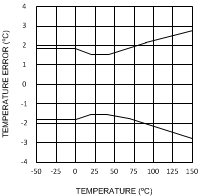 Figure 1. Temperature Error vs Temperature
Figure 1. Temperature Error vs Temperature
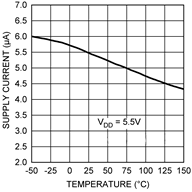 Figure 3. Supply Current vs Temperature
Figure 3. Supply Current vs Temperature
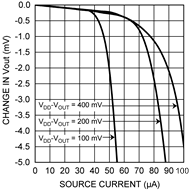 Figure 5. Load Regulation, Sourcing Current
Figure 5. Load Regulation, Sourcing Current
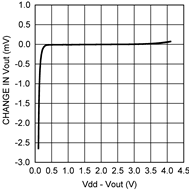 Figure 7. Change in Vout vs Overhead Voltage
Figure 7. Change in Vout vs Overhead Voltage
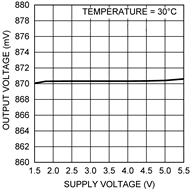 Figure 9. Output Voltage vs Supply Voltage
Figure 9. Output Voltage vs Supply Voltage
